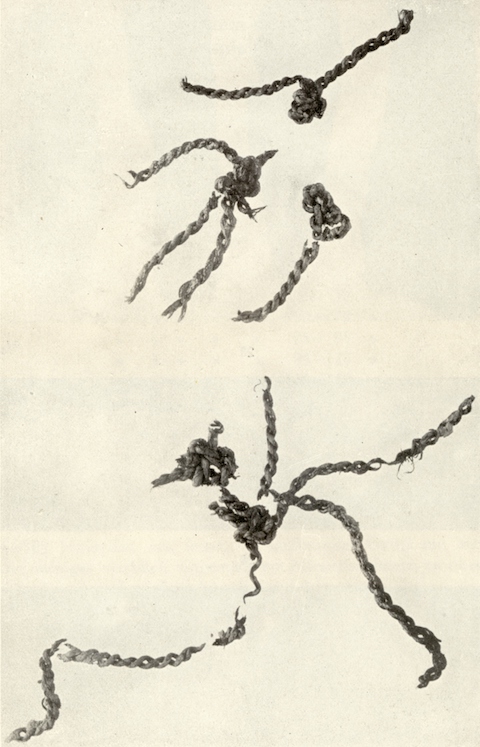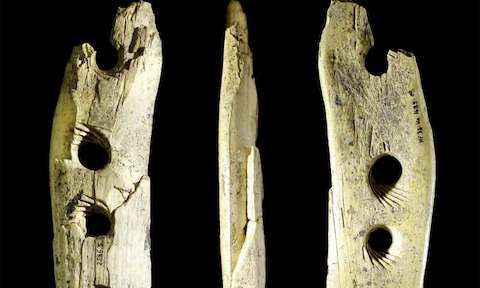
Credit: Sakari Pälsi, public domain, via Wikimedia Commons.
In the Stone Age, the most important tool was, yes, the stone. But what was second? Well, we’ll spin a yarn about that on this EarthDate, because it was … yarn, or string.
String is just plant fibers like cotton or hemp, or animal hair like sheep or llama wool, twisted together.
This simple invention allowed early humans to turn short fibers into long cords with many uses.
String tied stone points to spears and arrows. It strung a bow to shoot those arrows. It tied fishhooks made of shell to fishing poles. Or could be tied into fishnets.
Early humans wove string together to create rope for lashing things to their backs or slinging them over a shoulder, making life more mobile and freeing arms for collecting or climbing.
And they wove yarn into cloth—for clothing, carrying, bedding, shelter, and even sails.
String, and the things made from it, are perishable fibers, so not many ancient examples survived.
Still, we’ve found remnants in Paleolithic sites around the world, dating back more than 40,000 years. And from a Neanderthal site going back even farther.
Today, we use string and yarn every day, most commonly in our clothes, which are woven of the same old fibers, cotton and wool, along with a new generation of synthetics, made from oil.
So let’s all be glad we invented string. Without it, we might still be wearing animal skins—or less.
Background
Synopsis: Humans use string so regularly that we tend to take it for granted. String is a simple tool that can be strengthened by twisting or braiding into twine and rope. String also can be woven into textiles. Hominids began using string during the Paleolithic age, along with stone tools. String was used to fasten stones to spears for hunting and fishhooks to lines for fishing. Ropes lashed together shelters and rafts. Cords held mobile containers together, freeing up hominid arms for other purposes. String, like stone tools, created an instrumental advantage for us.
- String is a simple tool made of fibers twisted together to form a single continuous strand, and most of us depend on it every day.
- String can be crafted from plant fibers (such as cotton, flax, jute, or hemp) and yarn can be fashioned from animal fibers (such as sheep’s wool, alpaca, llama, angora, mohair, cashmere, and silk). Synthetic fibers are also used.
- String is created by spinning fibers together by hand or by using machines like spinning wheels to twist fibers in one direction, creating one ply.
- Multiple strands can be twisted together to increase strength and durability, creating twine.
- Most twines are compound ply, meaning the strands are twisted in the opposite direction from the direction they were spun to increase the strength of the resulting cord. Twining can be repeated, switching directions multiple times.
- String and twine can also be braided into strong rope or woven to create fabric.

Credit: User Damast on sv.wikipedia, CC BY-SA 3.0, via Wikimedia Commons.
- Researchers believe the invention of string and twine was second only to the development of stone tools in importance for hominid advancement and evolution.
- Cords were used to make fishing lines and nets.
- Twine was used to fasten points to arrows and spears and as bowstrings for hunting and protection.
- String was used in bow drills, which were used to make fire and to drill holes.
- Textiles could be used for clothing, shelter, bedding, and sails.
- String was used to assemble containers for carrying food and tools, freeing arms for other purposes, like collecting or climbing.
- Since it is made of perishable fibers, evidence of string is rare in the archaeological record. Paleolithic cord fragments been found in a few locations, including the following:
- Windover Bog, Florida (8,000 years old)
- Antrea, Russia (a fishing net from 8540 BCE is 10,560 years old)
- Lascaux Cave, France (17,000 years old)
- Ohalo II Site in Israel (19,000 years old)
- Dzudzuana Cave in the country of Georgia (30,000 years old)
- In Hohle Fels, Germany, a 40,000-year-old rope-twining tool carved from mammoth ivory was excavated.
- Indirect evidence, like beads found at early human excavations, suggests string may have been in use considerably earlier than 40,000 years ago.
- Evidence of early sea travel dating to at least 60,000 years ago also supports the notion that fibers were used for things like lashing rafts together.

Credit: University of Tübingen.
- It wasn’t just humans who were benefiting from string. Recent finds demonstrate that Neanderthals also used fiber technology.
- Recently a small piece of three-ply cord dated at 41,000–52,000 years old was discovered attached to the underside of a stone tool called a Levallois flake at a Neanderthal excavation site called Abri du Maras in southeastern France.
- The individual plies are twisted in one direction and are twined in the opposite direction. This is significant because twining materials to make multiple-ply cord requires an understanding of mathematical concepts like pairs and sets.
- Neanderthals occupied the site between 90,000 and 42,000 years ago.

Credit: MNHN (The French National Museum of Natural History)
- Qafzeh Cave in northern Israel provides even older indirect evidence of fiber use by hominids.
- Seashells found at the site show microscopic wear patterns that are consistent with having been strung together.
- Four of the shells are colored red with ochre, and all five have holes created by natural marine processes.
- The holes have microscopic striations around their edges, thought to be caused by hanging on a string, and the edges of the shells are worn where they once overlapped.
- The shells are estimated to be between 160,000 and 120,000 years old, but since the site was used on and off by both Homo sapiens (early humans) and Homo neanderthalensis (Neanderthals), it is difficult to determine which group strung the shells together.
- The use of string as a tool gave hominids distinct advantages.
- String, twine, and rope were important tools used for fishing, hunting, and gathering food; for lashing together loads, shelters, and rafts; and for warm clothing, bedding, and adornment.
- Other animals like primates and birds may use simple tools like sticks, but they don’t reuse them—these animals re-create a tool each time they need one.
- Using sinew or twine to create mobile containers enabled collection of useful tools ready for use any time they were needed.
- The use of containers to carry tools and food freed up hominid hands for other tasks, and for innovation.
- Modern civilization still depends on string! Imagine life without it.
